While the associated habitat destruction and pollution from a harbour city have their downsides for many species, there are some ‘man-made’ benefits.
Weirs increase the available habitat for freshwater species. Moorings can act as surrogate seagrass for many juvenile species as well as harbouring baitfish, shellfish and crustaceans, which in turn provide an increased food supply for bigger predators.
Marinas can provide shade and refuge from commercial nets for many species and even some pollution can benefit some species. Sydney’s old North Head sewer outlet had an abundance of species capable of utilising the extra nutrients.
And of course let’s not forget all the species that have benefited from the removal of their predators by commercial fishing. I’m sure all the squid along the east coast were very happy with the decline in kingfish numbers 20 years ago.
Moreton Bay in Queensland has seen a dramatic increase in blue swimmer crabs as a result of the increased food supply in the form of discarded ‘trawler trash’ from the commercial trawl fleet. Who would have ever thought that there would be an upside to discarded by-catch?
There are some species, kingfish for example, that although they use artificial made habitat, have probably not benefited all that much from it.
Lets have a look at some of the species that have done well directly as a result of human habitation.
Those algae and weed grazers, luderick and surgeon fish, are classic examples. Incidentally, most of what we refer to as ‘seaweed’ is not actually weed (an unwanted plant) at all, but simply aquatic vegetation. True sea weeds, likes Caulerpa and Salvinia, are invasive non-natives.
Luderick and surgeons also like the security and shade of structure. The first growth on newly-built structure is algae and weed.
Blackfish are opportunistic and quick. I had my boat parked at a marina the other day while I picked up some lunch. When I pulled the boat out of the water later that day, blackfish had grazed it clean of algae! You could clearly see the tooth structure and mouth shape in each little scrape.
Blackfish are possibly one of the most reliable angling species in the cooler months. They are found from the Heads right through the brackish reaches and I’ve even seen them in pure fresh water.
Blackfish rods have always been long but these days are of lighter construction.
There are a couple of reasons for the long rods. They are required to lift the belly of line that often forms between the rod tip and the float, and the extra length also cushions against the fish’s powerful lunges and helps avoid pulling the tiny hooks from their small mouths.
I prefer an egg-beater reel to the traditional centrepin and load it up with 2kg or 3kg line.
Quill floats are far more subtly efficient than the heavy, long-stemmed floats used for the ocean fish. A No 10 or 8 sneck pattern hook completes the rig.
River weed, which is the hair-like algae found in the brackish reaches, is the preferred bait for river blackfish.
The big bronzies found in the lower, more oceanic reaches love cabbage weed.
The bronzies are in the same class as those you would expect to find off the ocean rocks. They are of a good average size, around a kilo, and are much lighter in colour with prominent vertical bands.
They are found in much rougher country so the tackle must be scaled up a bit. Rods are slightly heavier in the butt section and 4kg or 5kg line is appropriate.
Heavier, long-stemmed floats are used and No 8 or No 6 hooks are more suited to these larger fish.
A burley of chopped weed and sand is a big advantage for river and ocean fishing.
Surgeon fish are found in the lower parts of the Harbour and around the ocean rocks and generally swim deeper than the blackfish, down at least 3m, so a running float rig works best for them. They make superb table fare but be careful of the scalpel-sharp tail scutes that give them their name.
Bream are another reliable Winter fish that have made good use of artificial structure.
Like blackfish, they like the security and shade of bridges, moorings, wharves, rock walls and navigation markers and their dietary requirements fit in nicely with the next thing that flourishes on structure after algae – shellfish and crustaceans.
Bream are found right throughout the system, from the freshwater reaches down to the ocean washes around the Heads.
The next piece of information is probably the most important and it relates to the bream’s feeding habits.
Bream source the bulk of their feed on the intertidal zone. This means that in general, the most productive sessions will be had on high tide and in shallow water.
To verify this, think about where and when you collect your prime bream baits. Yabbies, worms and pipis are all collected on the sand or mud flats at low tide. Black crabs, oysters and mussels are collected around the rocky foreshores and pylons, again, at low tide.
We access these creatures at low tide but the bream can only access them at high tide and that is where you will find them, especially early morning late afternoon and at night.
Don't be scared to get your boat right up against structure and if you’re fishing from the shore, cast along the bank, not as far as you can towards the middle.
Bream will eat almost anything providing its fresh and sometimes even when it's not fresh.
They are opportunist feeders but this does not mean that they will not actively hunt live prey. Stomach examination of most bream will nearly always reveal shell grit, particularly in the bigger specimens.
Top bream baits include:
• Dead but fresh – mullet and chicken gut, skirt steak, chicken breast fillet, prawns, fish flesh pieces.
• Live – prawns, yabbies, worms, pipis, mussels and black crabs.
Tackle for bream can be as simple as a handline and I know people who still prefer this method. More common these days is a rod and reel combo for 4kg to 6kg line.
The bait runner style of reel has become very popular among the majority who prefer to let their bream run before setting the hook.
This system allows the angler to let the fish run straight off the spool while the bail remains closed. A quick flick of the lever and the spool is engaged and you are in direct contact with the fish.
I don't let the fish run and find I get more positive hook-ups by striking immediately or just leaving the rod in the holder and letting the fish hook itself.
A light threadline or baitcasting outfit capable of holding 200m of 4kg matched to a light spinning rod about 1.8m would be ideal.
My rig consists of a running sinker above a swivel on the main line with a trace of about 50cm of 6kg line finished off with a No 4 to 1/0 hook, depending on the bait being used.
You should use only enough lead to hold bottom. Very often no lead at all will prove the most effective.
Lure fishing for bream has become very popular in recent years and seems to work better in some areas than others.
The most productive areas are the shallow, muddy areas where the water clarity is very low and where it is possible to flick a lure in, under and around any form of structure, either human made or otherwise. Oyster racks are a classic example
Leatherjacket numbers are better than they have ever been, due to the vastly increased habitat and food supply created by artificial structures. The fact that the structure also makes them almost completely inaccessible to commercial nets has been a major factor.
There are at least 10 species of leatherjacket available to Harbour, bay and offshore fishers around Sydney and most can be caught all year round. But they are a particularly great standby for the slow days in Winter.
Jackets cover a wide range of habitats from well up into the estuaries to the open sea and can be relied on even when all other species have gone off the bite.
Although not generally highly regarded as sport fish, they do give a good tussle on light line.
Jackets are also delicious and very high in those healthy omega 3 fats, so you can justify those couple of chardonnays you had while cooking them.
Good spots to try include around bridge pylons, marinas, jetties, reefs and rocky points. They love tiny pieces of prawn bait and, because they have very small mouths, hooks need to be kept small.
Fish your bait about 1m off the bottom and wait until you feel that slow suck characteristic of jackets. Don’t strike immediately; wait a few seconds to let the fish get it into its tiny mouth.
Jackets should be skinned before cooking.
Reads: 2725
Luderick and surgeons are often found together, with the surgeons likely to be in slightly deeper water.
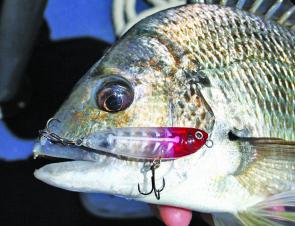
Bream rely on the intertidal zone to provide much of their diet but in warmer times will track down surface lures and in cooler water can hang deep and chase small baitfish.

Buoys like this present impressive structure but don't forget that they are also anchored to the sea bed by a much bigger block.
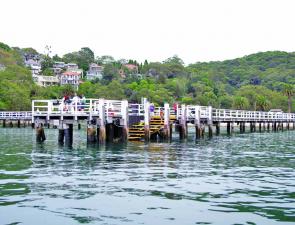
Deepwater jetties offer plenty of cover and food.
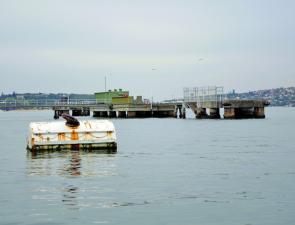
Check your charts because some jetties, like this one at Clifton Gardens, are in naval waters.
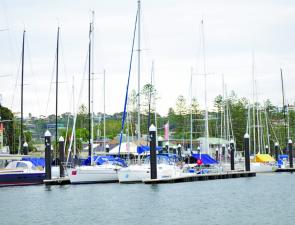
With the banning of tributyl tin antifouling, marinas now offer a smorgasbord of food to rival the Sydney Fish Market.

Chinaman jackets are excellent eating but can be a nuisance when targeting other species.
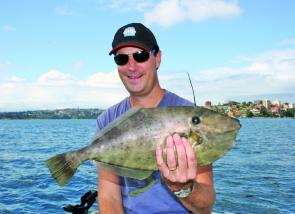
The unicorn jacket is a rare tropical visitor to the Harbour.
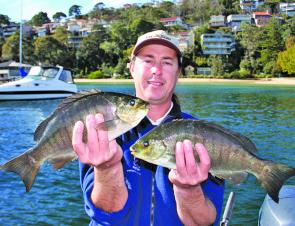
Luderick have thrived on the extra food and protection offered by man-made structure.

Fan belly jackets will take lures worked deep.




